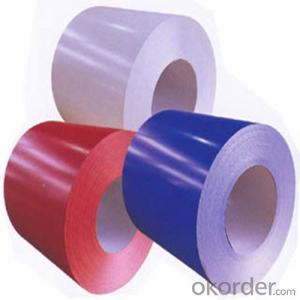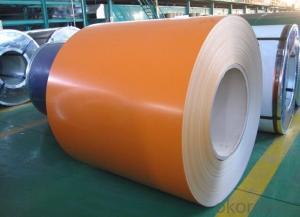Pre-painted Galvanized Steel Coil for Good Price
- Loading Port:
- Tianjin
- Payment Terms:
- TT OR LC
- Min Order Qty:
- 100 m.t.
- Supply Capability:
- 5000 m.t./month
OKorder Service Pledge
OKorder Financial Service
You Might Also Like
1. Defination of Prepainted Galvanized Steel Coil
Pre-painted coils are produced by coating a layer of paint on the surface of cold rolled, galvanized or galvalumed coils. Aesthetic appeal and durability are the key festures of color coated steel coil. A wide selection of colors is available to the customer and paints designed to meet specific end use could be specified.
2. Applications of Prepainted Galvanized SteelCoil
1) Buildings and constructions: roofing, ceilings, gutters, venting lines, indoor decorations, window frames, etc.
2) Electrical appliances: computer shells, washing machines, refrigerators, dehumidifiers, video recorders, water heaters, etc.
3) Agricultural equipments: troughs, feeding tools, agricultural driers, irrigation channels, etc.
4) Vehicle parts: back-seat plates of buses and trucks, conveying systems, oil tanks, etc.
3. Specifications of Prepainted Galvanized SteelCoil
Standard: ASTM;ASTM;JIS;GB
Grade: SGCC;(DX51D)
Thickness: 0.12-1.2mm
Width: 750-1250mm
Length: Coil or customer's requirements
Zinc Coating: 60-140g/m2
Painting : Top side from 15-25um; Bottom side from 5-10 um
Color : RAL numbers or customers' sample color
Application: building trade, electric apparatus, furniture and transport service
Production arts and crafts : Double coated double drying
Coil ID: 508mm
Coil Weight: 3-6 Ton
Type :coil
Packaging Detail: Fully seaworthy export packing with paper tube or as per customer's requirements
4. Prepainted Galvanized Steel Coil Images


5. Advantages of Our Prepainted Galvanized SteelCoil
1) Excellent corrosion resistance: The zinc layer provides a good protection of Pre-painted Galvanizeed Steel Sheet.
2) High heat resistance: The reflective surface of the material aids in efficiently reflecting the sunlight away and in turn reducing the amount of heat transmitted. The thermal reflectivity converts into energy savings.
3) Aesthetics: Pre-Painted Galvanized steel sheet is available in plethora of patterns and multiple sizes as per the requirements that given by our customers.
4) Versatility: can be used in the various areas.
6. FAQ
We have organized several common questions for our clients,may help you sincerely:
1) How about your company?
A world class manufacturer & supplier of castings forging in carbon steel and alloy steel,is one of the large-scale professional investment casting production bases in China,consisting of both casting foundry forging and machining factory. Annually more than 8000 tons Precision casting and forging parts are exported to markets in Europe,America and Japan. OEM casting and forging service available according to customer’s requirements.
2) How to guarantee the quality of the products?
We have established the international advanced quality management system,every link from raw material to final product we have strict quality test;We resolutely put an end to unqualified products flowing into the market. At the same time, we will provide necessary follow-up service assurance.
3) How long can we receive the product after purchase?
In the purchase of product within three working days, We will arrange the factory delivery as soon as possible. The pecific time of receiving is related to the state and position of customers.Commonly 7 to 10 working days can be served.
- Q: Are steel sheets suitable for high-vibration environments?
- Yes, steel sheets are suitable for high-vibration environments. Steel is a strong and durable material that can withstand vibrations without experiencing significant deformation or damage. It is commonly used in industries such as construction, automotive, and aerospace, where high-vibration environments are common. Additionally, steel sheets can be designed and manufactured to have vibration-damping properties, further enhancing their suitability for such environments.
- Q: What is the typical yield strength of steel sheets?
- The yield strength of steel sheets can vary depending on the grade and type of steel used, with mild steel sheets commonly used in construction and manufacturing having a typical yield strength of around 250 megapascals (MPa) or 36,000 pounds per square inch (psi). Higher strength steels, like high-strength low-alloy (HSLA) steels or advanced high-strength steels (AHSS), can exhibit yield strengths ranging from 300 to 600 MPa (43,500 to 87,000 psi) or even higher. It is important to note that these values are general estimates and specific steel grades may possess slightly different yield strengths.
- Q: What are the different sizes of steel sheets available?
- Steel sheets are available in a wide range of sizes, catering to various applications and industries. The sizes of steel sheets can vary depending on factors such as thickness, width, and length. In terms of thickness, steel sheets are commonly available in gauges ranging from 7 to 30. The higher the gauge number, the thinner the sheet. Thinner sheets, such as those with a gauge of 30, are often used for applications that require flexibility, while thicker sheets, such as those with a gauge of 7, are typically used for heavy-duty applications that require high strength and durability. When it comes to width, steel sheets are available in a range of options. The most common widths include 36 inches, 48 inches, and 60 inches. However, customized widths can be obtained for specific requirements. Regarding length, steel sheets are typically available in standard lengths of 96 inches and 120 inches. These lengths are commonly used in various industries. However, like width, the length can also be customized to fit specific needs. It is important to note that the availability of different sizes of steel sheets may vary depending on the supplier and the specific grade of steel being used. It is advisable to consult with a steel sheet supplier or manufacturer to determine the exact sizes available for a particular application.
- Q: What is the typical lifespan of painted steel sheets?
- The typical lifespan of painted steel sheets can vary depending on several factors such as the quality of the paint used, the environmental conditions they are exposed to, and the maintenance and care given to the sheets. Generally, painted steel sheets can last anywhere from 20 to 40 years. However, if the paint is of high quality and the sheets are properly maintained, their lifespan can be extended even further. Regular cleaning, inspection for any signs of damage or corrosion, and appropriate touch-ups or repainting can help prolong the lifespan of painted steel sheets. Additionally, factors such as exposure to harsh weather conditions, chemicals, or corrosive environments can also impact the longevity of painted steel sheets. It is worth considering these factors and conducting regular maintenance to ensure the extended lifespan of painted steel sheets.
- Q: Are steel sheets resistant to scratching or abrasion?
- Yes, steel sheets are generally resistant to scratching or abrasion due to their strong and durable nature.
- Q: What are the different methods of surface preparation for steel sheets?
- Some of the different methods of surface preparation for steel sheets include sandblasting, chemical cleaning, mechanical cleaning, and power tool cleaning.
- Q: What is called steel plate sanding process?
- Sand blasting can remove the oxide surface and floating rust on the surface of steel plate. It is a good process before anticorrosion painting. Sandblasting of other components may be more useful for pre coating treatment.
- Q: What is the typical weight of steel sheets?
- Steel sheets come in a variety of sizes, thicknesses, and types, so their typical weights can differ. In general, the weight of steel sheets can range from a few pounds to several tons. For instance, a regular 4x8 foot steel sheet that is 1/4 inch thick weighs approximately 110 pounds, while a larger 10x10 foot sheet that is 1 inch thick can weigh over 1,000 pounds. It should be noted that these estimates are only rough guidelines, and the weight can vary depending on specific factors like the alloy composition or any coatings applied to the sheets.
- Q: What are the different strength properties of steel sheets?
- The different strength properties of steel sheets include yield strength, tensile strength, and elongation. Yield strength refers to the maximum amount of stress a material can withstand without permanent deformation. Tensile strength is the maximum amount of stress a material can handle before breaking. Elongation is the measure of how much a material can stretch or deform before breaking. These strength properties are important factors to consider when determining the suitability of steel sheets for various applications.
- Q: What is the average fire rating for steel sheets?
- The average fire rating for steel sheets can vary depending on various factors, such as the thickness of the sheet, the type of steel used, and the specific fire testing standards that are being followed. Typically, steel sheets have a fire rating ranging from 30 minutes to 2 hours. However, it is important to note that fire ratings can be enhanced by incorporating additional fire-resistant materials or by using fire-resistant coatings on the steel sheets. It is always recommended to consult with fire safety experts or refer to the specific fire testing standards to determine the exact fire rating for a particular type of steel sheet.
Send your message to us
Pre-painted Galvanized Steel Coil for Good Price
- Loading Port:
- Tianjin
- Payment Terms:
- TT OR LC
- Min Order Qty:
- 100 m.t.
- Supply Capability:
- 5000 m.t./month
OKorder Service Pledge
OKorder Financial Service
Similar products
Hot products
Hot Searches
Related keywords




























